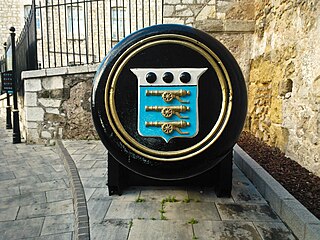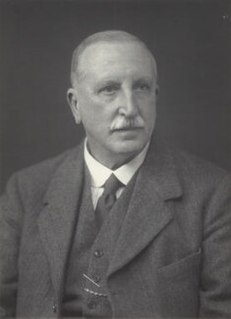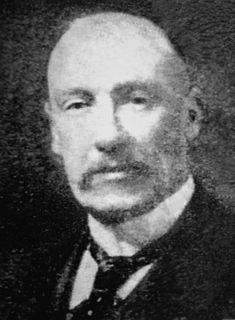
The Board of Ordnance was a British government body. Established in the Tudor period, it had its headquarters in the Tower of London. Its primary responsibilities were 'to act as custodian of the lands, depots and forts required for the defence of the realm and its overseas possessions, and as the supplier of munitions and equipment to both the Army and the Navy'. The Board also maintained and directed the Artillery and Engineer corps, which it founded in the 18th century. By the 19th century, the Board of Ordnance was second in size only to HM Treasury among government departments. The Board lasted until 1855, at which point it was disbanded.

The post of Controller of the Navy was originally created in 1859 when the Surveyor of the Navy's title changed to Controller of the Navy. In 1869 the controller's office was abolished and its duties were assumed by that of the Third Naval Lord whose title then changed to Third Naval Lord and Controller of the Navy. In 1904 the title was changed again to Third Sea Lord and Controller of the Navy. In 1965 the office of the Third Sea Lord was abolished. The post-holder is responsible for procurement and matériel in the British Royal Navy.
Major-General William Roy was a Scottish military engineer, surveyor, and antiquarian. He was an innovator who applied new scientific discoveries and newly emerging technologies to the accurate geodetic mapping of Great Britain. His masterpiece is usually referred to as Roy's Map of Scotland.

The Ramsden surveying instruments are those constructed by Jesse Ramsden and used in high precision geodetic surveys carried out in the period 1784 to 1853. This includes the five great theodolites—great in name, great in size and great in accuracy—used in surveys of Britain and other parts of the world. Ramsden also provided the equipment used in the measurement of the many base lines of these surveys and also the zenith telescope used in latitude determinations.

Colonel Sir Charles Frederick Arden-Close, was a British geographer and surveyor. He was Director General of the Ordnance Survey from 1911 to 1922. His insistence on attention to detail saw the improvement of many attitudes and methods at the Ordnance Survey. Close's planning saw the production of many maps now viewed as pinnacles in the classic period of map making. He was born Charles Frederick Close and changed his surname to Arden-Close in 1938 so as to comply with a bequest.

Julius Erasmus Hilgard was a German-American engineer.

James Pugh Kirkwood was a 19th-century American civil engineer, and general superintendent of the Erie Railroad in the year 1849–1850. He left the Erie to go to the southwest to construct railroads, and he made the first survey for the Pacific Railroad west from the Mississippi to the Rocky Mountains. Late 1860s he served as President of the American Society of Civil Engineers.
William Yolland CB, FRS FRSA was an English military surveyor, astronomer and engineer, and was Britain's Chief Inspector of Railways from 1877 until his death. He was a redoubtable campaigner for railway safety, often in the face of strong opposition, at a time when railway investment was being directed towards the expansion of the networks rather than the prevention of accidents. He was a member of the three-man committee of inquiry into the Tay Bridge disaster.

Col Alexander Ross Clarke FRS FRSE (1828–1914) was a British geodesist, primarily remembered for his calculation of the Principal Triangulation of Britain (1858), the calculation of the Figure of the Earth and one of the most important text books of Geodesy (1880). He was an officer of the Royal Engineers employed on the Ordnance Survey.
Ordnance sergeant was an enlisted rank in the U.S. Army from 1832 to 1920. The Confederate States Army also had an ordnance sergeant position during its existence. Ordnance sergeants were part of the Army's Ordnance Department and were in charge of the ordnance stores at a particular fort or other Army post. Often they led caretaker detachments or were the sole caretakers of ungarrisoned fortifications and other facilities. In both armies the rank insignia consisted of three inverted chevrons with a 5-pointed star above it.

Sir Ernest Woodford Birch, was a British colonial administrator who served as the eighth British resident of Perak (1904–1911).

Ordnance Survey (OS) is the national mapping agency for Great Britain. The agency's name indicates its original military purpose, which was to map Scotland in the wake of the Jacobite rising of 1745. There was also a more general and nationwide need in light of the potential threat of invasion during the Napoleonic Wars. Since 1 April 2015 Ordnance Survey has operated as Ordnance Survey Ltd, a government-owned company, 100% in public ownership. The Ordnance Survey Board remains accountable to the Secretary of State for Business, Energy and Industrial Strategy. It was also a member of the Public Data Group.
The Queen's Birthday Honours 1958 were appointments in many of the Commonwealth realms of Queen Elizabeth II to various orders and honours to reward and highlight good works by citizens of those countries. The appointments were made to celebrate the official birthday of The Queen. They were published on 3 June 1958 for the United Kingdom and Colonies, Australia, New Zealand, Ghana, and the Federation of Rhodesia and Nyasaland.

William Ezra Worthen was a Harvard-educated American civil engineer. He was President of the American Society of Civil Engineers in 1887, and elected an Honorary Member in 1898.
The Anglo-French Survey (1784–1790) was the geodetic survey to measure the relative position of Greenwich Observatory and the Paris Observatory via triangulation. The English operations, executed by William Roy, consisted of the measurements of bases at Hounslow Heath (1784) and Romney Marsh (1787), the measurements of the angles of the triangles (1787–1788) and finally the calculation of all the triangles (1788–1790). The survey is very significant as the first precise survey within Britain, and the forerunner of the work of the Ordnance Survey which was founded in 1791, one year after Roy's death.
The 1948 New Year Honours were appointments by many of the Commonwealth realms of King George VI to various orders and honours to reward and highlight good works by citizens of those countries. They were announced on 1 January 1948 for the British Empire and New Zealand to celebrate the past year and mark the beginning of 1948. By coincidence it coincided with the nationalization of the Big Four railways into what is now known as British Railways.
The King's Birthday Honours 1942 were appointments by King George VI to various orders and honours to reward and highlight good works by members of the British Empire. They were published on 5 June 1942 for the United Kingdom and Canada.
The King's Birthday Honours 1929 were appointments by King George V to various orders and honours to reward and highlight good works by members of the British Empire. The appointments were made to celebrate the official birthday of The King. They were published on 3 June 1929.
The 1927 Birthday Honours were appointments by King George V to various orders and honours to reward and highlight good works by citizens of the British Empire. The appointments were made to celebrate the official birthday of The King, and were published in The London Gazette on 3 June 1927.
James Gardner was an English surveyor, lithographer, cartographer, engraver and publisher who played an active role in the trigonometrical survey of Great Britain. His career spanned the years 1808 to 1840.









